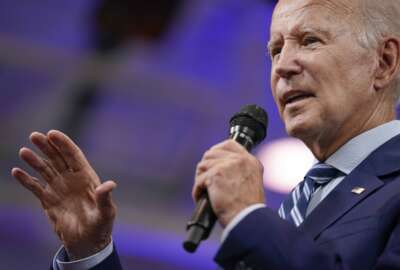Employee engagement in the federal workforce steadied in the 2022 Federal Employee Viewpoint Survey (FEVS), after a couple tumultuous years following the COVID-19 pandemic.
The results of the 2022 FEVS showed a governmentwide employee engagement score of 71%, the Office of Personnel Management announced on Oct. 20. The score is the same as the 2021 FEVS, but a 1% drop compared with the 2020 FEVS.
Global satisfaction for feds, though, slipped further down in the 2022 FEVS, now at 62%, compared with 64% in 2021. The job satisfaction index slightly declined to 66% this year, down from 67% in 2021, and 72% in 2020. Pay satisfaction saw a sharper decrease, at 56% for 2022. That’s 5% below last year’s score of 61%.
Despite the decline in some measures of the 2022 FEVS, OPM said employee engagement is similar to, if not slightly better than, that of the U.S. workforce overall, which has declined 4% over the past two years.
“Amid unprecedented challenges, federal employees remain remarkably resilient, engaged and committed to public service,” OPM Director Kiran Ahuja said in a statement.
Return-to-office and telework policies
One of those challenges for the federal workforce remains the future of telework and remote work. Hybrid work schedules have become increasingly common for federal employees, and this year’s FEVS further revealed how feds felt about agencies’ telework and remote work opportunities.
“Federal employees are finding creative solutions to stay connected to their teams, leverage workplace flexibilities and remain motivated to continue doing the critical work on behalf of the American people,” Ahuja said.
OPM continued to monitor feds’ feelings about working in physical office spaces following the pandemic. The agency used FEVS to test the temperature on operations being performed in physical office spaces, versus those being performed remotely.
“Questions about returning to the physical workplace after engaging in maximum telework were added to gain a better understanding of the role remote and hybrid work plays in agency effectiveness,” OPM said.
Governmentwide, 14% of feds have remote work arrangements, while 25% of feds telework three days or more per week. That’s lower when compared with the 2021 FEVS results, when 36% of respondents said they were teleworking every day. In the 2020 FEVS, that measure was at 47%.
Ahuja has also said that federal employees are “agency-hopping” to more telework-friendly offices, making the role of telework all the more imminent for agencies.
For those anticipating changes to their agency’s telework policy, 68% agreed that senior leaders were effectively communicating return-to-office plans. Additionally, 74% of respondents said they would not leave their current position based on current telework and remote work arrangements.
Immediate supervisors received higher scores than senior leaders for the 2022 FEVS, a typical trend for the survey each year. For example, 84% of respondents agreed that their supervisor supports employees’ efforts to stay healthy and safe while working. But when asked about higher up managers, just 74% of respondents agreed that senior leaders supported policies and procedures to protect employees’ health and safety.
A new index for DEIA
Following a more pared-down version of FEVS in both 2020 and 2021, OPM added several measurements to expand this year’s governmentwide survey.
The 2022 FEVS included an entirely new section on diversity, equity, inclusion and accessibility, as part of the White House’s executive order on advancing DEIA in the federal workforce. According to the new index, 69% of governmentwide respondents said they have positive perceptions of agencies’ DEIA practices. Small agencies had higher perceptions of DEIA initiatives, at 76%.
The survey also asked questions about how employees felt regarding management practices for promoting diversity, and if advancement opportunities were equal among all employees in a given work unit.
“These government-wide results will serve as a baseline to assess future changes as well as benchmark comparisons for agency DEIA initiatives,” OPM wrote.
Another factor OPM measured was at the intersection of DEIA and telework. Notably, 53% of respondents agreed that their agency’s reentry arrangements are fair in accounting for employees’ diverse needs and situations.
Separate from DEIA questions, OPM also asked respondents about their use of the paid parental leave program for federal employees. About 4% of federal employees said they used the program, with 81% of those using the program actually taking off the full 12 weeks available. Of those who took off fewer than 12 weeks for paid parental leave, 57% said it was because they didn’t feel they could be away from their job responsibilities for that long.
Looking to the future of the growing hybrid workforce, OPM added a new component of “innovation” to FEVS this year as well. On that scale, 56% of respondents agreed that their managers encourage new ways to improve agency work.
The 2022 iteration of FEVS received a total of 557,778 responses from federal employees, resulting in a 35% response rate. That’s about on par with the 34% response rate for 2021, but significantly lower than the 44% response rate for 2020 FEVS, and 43% in 2019.
This year’s FEVS also marked OPM’s return to the regular fall timeline for the survey, after having delayed the release of the survey results for the first two years following the pandemic.
Copyright
© 2024 Federal News Network. All rights reserved. This website is not intended for users located within the European Economic Area.
